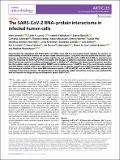The SARS-CoV-2 RNA–protein interactome in infected human cells
Author(s)
Schmidt, Nora; Lareau, Caleb A.; Keshishian, Hasmik; Ganskih, Sabina; Schneider, Cornelius; Hennig, Thomas; Melanson, Randy; Werner, Simone; Wei, Yuanjie; Zimmer, Matthias; Ade, Jens; Kirschner, Luisa; Zielinski, Sebastian; Dölken, Lars; Lander, Eric Steven; Caliskan, Neva; Fischer, Utz; Vogel, Jörg; Carr, Steven A.; Bodem, Jochen; Munschauer, Mathias; ... Show more Show less
DownloadPublished version (4.019Mb)
Publisher with Creative Commons License
Publisher with Creative Commons License
Creative Commons Attribution
Terms of use
Metadata
Show full item recordAbstract
Characterizing the interactions that SARS-CoV-2 viral RNAs make with host cell proteins during infection can improve our understanding of viral RNA functions and the host innate immune response. Using RNA antisense purification and mass spectrometry, we identified up to 104 human proteins that directly and specifically bind to SARS-CoV-2 RNAs in infected human cells. We integrated the SARS-CoV-2 RNA interactome with changes in proteome abundance induced by viral infection and linked interactome proteins to cellular pathways relevant to SARS-CoV-2 infections. We demonstrated by genetic perturbation that cellular nucleic acid-binding protein (CNBP) and La-related protein 1 (LARP1), two of the most strongly enriched viral RNA binders, restrict SARS-CoV-2 replication in infected cells and provide a global map of their direct RNA contact sites. Pharmacological inhibition of three other RNA interactome members, PPIA, ATP1A1, and the ARP2/3 complex, reduced viral replication in two human cell lines. The identification of host dependency factors and defence strategies as presented in this work will improve the design of targeted therapeutics against SARS-CoV-2.
Date issued
2020-12Department
Massachusetts Institute of Technology. Department of BiologyJournal
Nature Microbiology
Publisher
Springer Science and Business Media LLC
Citation
Schmidt, Nora et al. "The SARS-CoV-2 RNA–protein interactome in infected human cells." Nature Microbiology (December 2020): doi.org/10.1038/s41564-020-00846-z. © 2020 The Author(s)
Version: Final published version
ISSN
2058-5276